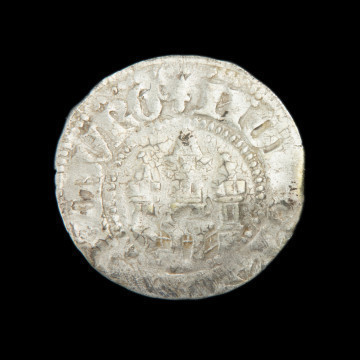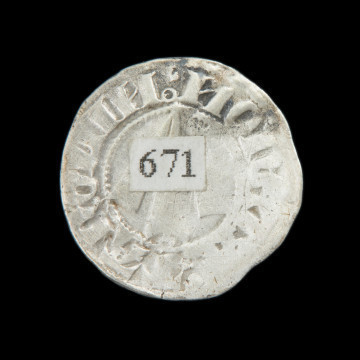
Witten
1370
National Museum in Szczecin
Part of the collection: Szczecin treasure from Podzamcze
One of the most valuable archaeological finds in post-war Szczecin is the so-called Podzamcze treasure dating from the 14th/15th centuries, discovered during excavations in 1999. The grapen, a three-legged metal vessel with a ceramic lid, which rested under the floor of a tenement house at Targ Rybny (Fishmarkt), contained silver-gilt ornaments (rings, clasps, buckles and belt fittings, buttons, garment appliqués, pins, knife handle fittings) and coins (witten and thick pfennigs) minted mainly in Western Pomerania, especially in Strzałów (Stralsund) and Gryfia (Greifswald). The value of the coins has been estimated at nine Lübeck fines, which was not a large fortune at that time. Among them was the so-called witten, a coin exemplifying municipal minting, characteristic especially for Strzałów (Stralsund), which, together with other Pomeranian towns, following the example of the main centres of the Hanseatic League - Lübeck and Hamburg, introduced a denomination higher than the denarius in the second half of the 14th century. Strzałów (Stralsund), Szczecin (Stettin), Gryfia (Greifswald), Dymin (Demmin), Tąglim (Anklam) and Wołogoszcz (Wolgast) concluded an agreement on minting wittens - a coin of 4 denars according to one minting system and with the same stamp. However, as the only centre, Stralsund had the privilege to guarantee full minting rights, with its depiction on the stamp, the Gothic letter S as the initial of the town's name. It led to the creation of the characteristic Arrowhead wittens, sometimes accompanied by religious sentences, such as DEUS IN NOMINE TUO (God in Thy Name).
Małgorzata Peszko
Dimensions
cały obiekt:
Object type
coin
Creation time / dating
Creation / finding place
Identification number
Location / status

1370
National Museum in Szczecin

XV wiek
National Museum in Szczecin

XV wiek
National Museum in Szczecin
DISCOVER this TOPIC
National Museum in Szczecin
DISCOVER this PATH
Educational path